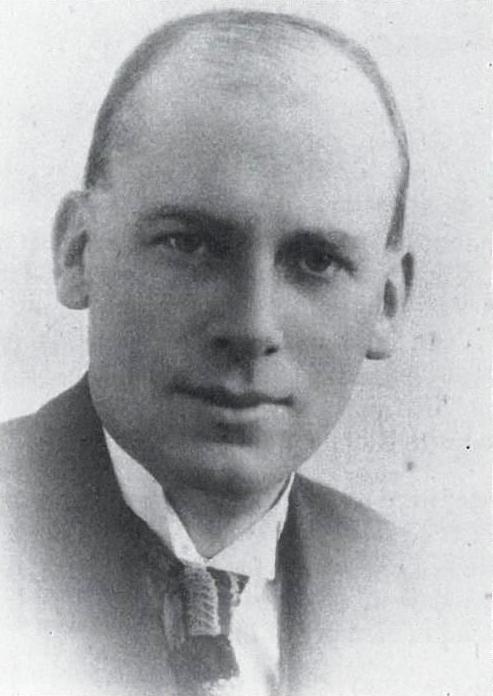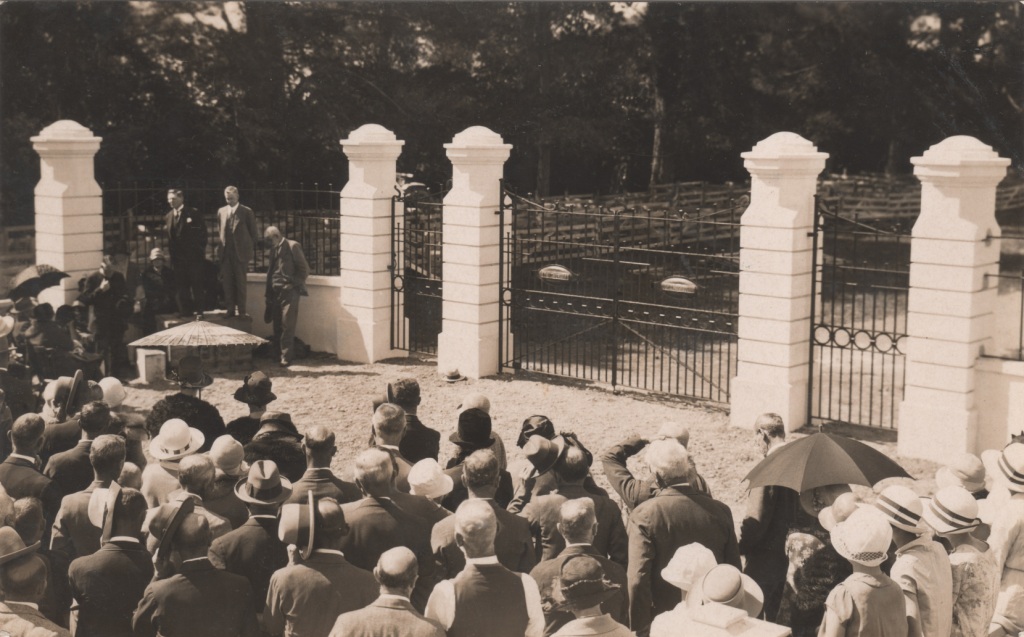Dr. Hubert Oscar Washbourn
Dr Washbourn and the Washbourn Memorial Gates Dr Hubert Oscar Washbourn, known by family as Pete, arrived in Richmond in 1919 and during this year he bought Hillcrest Private Hospital.
Dr Washbourn and the Washbourn Memorial Gates
Dr Hubert Oscar Washbourn, known by family as Pete, arrived in Richmond in 1919 and during this year he bought Hillcrest Private Hospital. It was here that he established a specially equipped building for electrical treatment, mostly for clients who were crippled with rheumatism.1 Washbourn Gardens, and the iconic house in it, were built for Dr Washbourn in 1924.2 The Washbourn Gardens are now a popular amenity.
Hubert Washbourn died on 10 July 1927, aged 40 years, as a result of an acute attack of pneumonia. He was the youngest son of Mr and Mrs Henry Phillip Washbourn, of Port Nelson. Mr Henry Washbourn was involved in mining and haematite paint manufacture in Golden Bay.3 Hubert's grandfather, William Everly Washbourn of Tillingdown, Surrey, emigrated to Nelson Province in 1851.
Hubert was educated at Nelson College and, after a short term on the staff of the Bank of New Zealand, Nelson, decided to take up studies for his medical degree. He went to Edinburgh University, where he achieved his ambition, and after experience in Durham, England he returned to Nelson in June 1914 and commenced practice at Richmond in 1919.4 He married Constance Olave Ward on 24 October 1913 in Edinburgh. They had one son, and two daughters. Hubert had two older brothers: Dr Henry Everley Arthur Washbourn, a surgeon of Nelson, and (Frank) Francis Irvine Washbourn, a dentist of Timaru.
In private life Dr. Washbourn's hobby was breeding Jersey cattle. To this he brought his well-known enthusiasm and imported the best of stock into the district, including some direct from Jersey Island. He was the first president of the Nelson Jersey Cattle Breeders' Club and, until his death, was a member of the executive of the New Zealand Jersey-Cattle Breeders' Association. At the time of his death Dr. Washbourn had just been elected president of the Nelson Agricultural and Pastoral Association. He took a very keen interest in the work of the Association and in the farming community generally. He was also keenly interested in all athletic sports and gave considerable encouragement to various sports bodies.
Dr Washbourn was greatly respected by the Richmond community. In the Government Gazette, Local Legislation No 48 section 75 an order was passed on 9 October 1928 making provision for one acre of the Nelson Agricultural and Pastoral Association land to be vested in the Richmond Borough for recreation purposes, as a memorial to the late Hubert Oscar Washbourn. This was to be known as the "Washbourn Memorial Park". This provision has been long forgotten.
The following account is of the unveiling of the memorial gates to Dr Washbourn, presumably located at the entrance to the gazetted Washbourn Memorial Park acre. “On 17 November 1928 the Washbourn Memorial Gates at Richmond Park were unveiled this afternoon in the presence of a large assembly of Richmond residents and others. The gates are of handsome design in wrought iron. They consist of a 12-inch fall in the centre for vehicular traffic, and a 4-foot gate on each side for people on foot. Six massive posts and a sweep of wing wall on each side make the whole approach most attractive. The gates were designed by Messrs. Houlker and Duke, architects, and the work was carried out by Mr. Robert. Powrie. In unveiling the memorial shields, which bear the inscription, 'In Memoriam—Dr. H. O. Washbourn. Mr. J. Hunt, Mayor of Richmond, paid a tribute to the sterling qualities of the late Dr. Washbourn, and to the good work he had done in the district. He then formally handed the gates over to Mr. Harkness, secretary of the Nelson A. and P. Society, who suitably acknowledged the generosity of the many subscribers. The gates were then thrown open for inspection, and Mrs. H. O. Washbourn drove through them into the park.”5
2015
Updated May, 2020
Story by: Ken Wright
Sources
- Sutton, J. (1992). How Richmond Grew. Richmond, N. Z.: J. Sutton
- Kearns., P. (2011,August 3) Hillcrest Hospital in the 1800s Waimea Weekly, p.18
http://issuu.com/waimea-weekly/docs/03082011/1 - Newport, JMW. (1979) Some industries of Golden Bay. Nelson Historical Society Journal, 3(5)
- The Press, 10 July 1927
- The Washbourn Gates. Unveiling ceremony (1928, 19 November), Evening Post. p.4
Further Sources
Books
- Robinson, K. (2019). From the country to the town : a history of the Nelson A. & P. Association. Nelson, N.Z.: Nelson Agricultural & Pastoral Association. http://www.worldcat.org/oclc/1134451702
- Sutton, J. (1992). How Richmond Grew. Richmond, N.Z.: J. Sutton. http://www.worldcat.org/title/how-richmond-grew/oclc/34876506
- Washbourn, H.P. (c.1933) Reminiscences of early days. Nelson, N.Z.: R Lucas. http://www.worldcat.org/oclc/153339717
Newspapers
- Newport, JMW. (1979) Some industries of Golden Bay. Nelson Historical Society Journal, 3(5)
http://nzetc.victoria.ac.nz/tm/scholarly/tei-NHSJ03_05-t1-body1-d2.html - The Washbourn Gates. Unveiling ceremony (1928, 19 November), Evening Post. p.4
http://paperspast.natlib.govt.nz/cgi-bin/paperspast?a=d&cl=search&d=EP19281119.2.17

